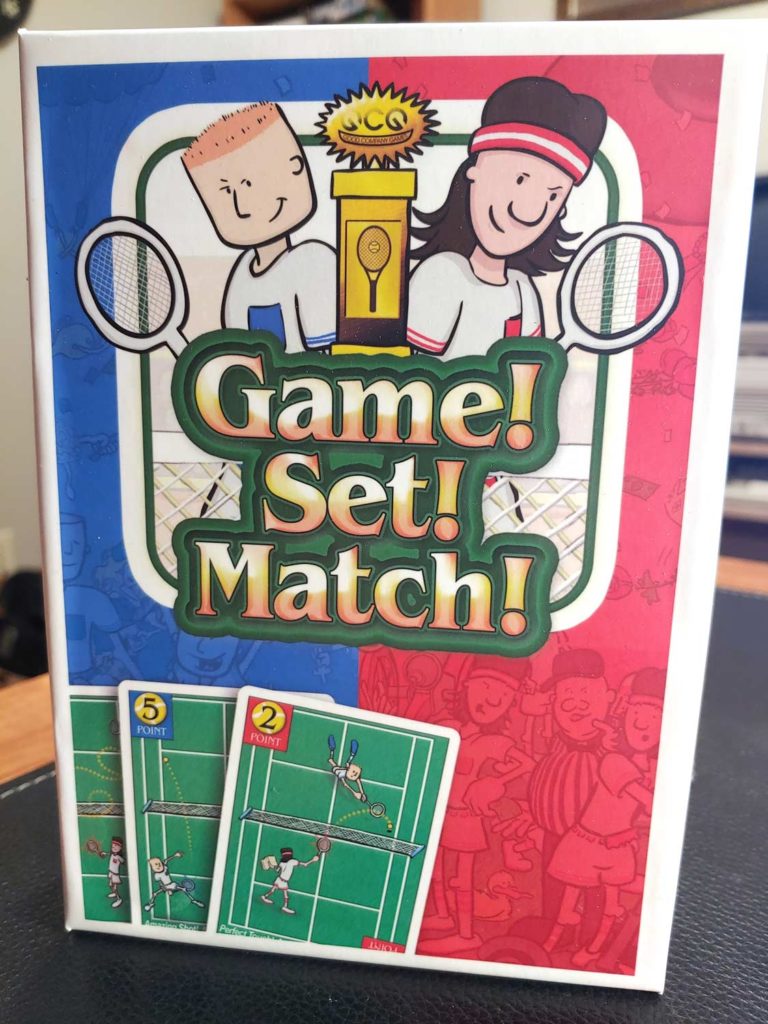Tennis is a fun game with a rich, centuries-old tradition. Conceptually simple, easy to learn, and hard to master, tennis has already been transported to the tabletop in the form of Ping Pong. But can the “sport of kings” serve up big fun as a card game?
Overview
Game! Set! Match! is a lightweight, 2-4 player card game for ages 13+ with a playing time of 30-45 minutes. Players will choose between identical red or blue decks and play both their cards and tokens (in the shape of tennis balls) to gain momentum throughout each mini game. The player who takes 6 mini games first is declared the overall winner.

How To Play
Game! Set! Match! is delightfully simple to setup and play. Like most centuries-old sports, tennis has unintuitive scoring terms, with points scoring “Love,” 15, 30, 40, and sometimes “Deuce.” (There are multiple theories on how these terms originated.) Fear not, because Game! Set! Match! has tracks that smoothly manage scoring regardless of your tennis background.

The board features a central Momentum track shaped like a tennis stadium with numbered spaces 0-19. During each mini game, two colored tokens (1 red & 1 blue) start at “0” and race around the stadium to tally the values of any cards or tokens played during that mini game. When you play a Point card or a Ball Token, the player with the better Momentum will score a point. The first player to score four points wins the mini game.
The colored Ball Tokens have values ranging from +3 to -3, which first adjust Momentum and then automatically score a point for the player with the better Momentum. Ball Tokens are always used at the beginning of a mini game as the opening “Serve.” After each mini game, players swap turns being the Server, which is a first-player token that breaks Momentum ties when scoring a point.

The red and blue player decks are identical and feature three types of cards: Volley, Point, and Special.
Volley: Adjust Momentum only
Point: Adjust Momentum & score a Point for leading player
Special: Adjust Momentum & resolve text instructions on the card
The players begin with 8 cards drawn at random from their respective decks. Players alternate placing cards or tokens in the play area to adjust their Momentum, also scoring points when Point cards or Ball Tokens are played. When a player reaches four points scored, they earn one game on the Set scoring track.
To begin the next mini game, reset point scoring and Momentum tracks, swap the Server token, and draw three more cards from your deck. The match continues until one player reaches 6 mini game victories.
Kudos (What Worked)
Tennis is known for a combination of quick points (like a service “Ace”) and long “rallies” where players hit and return the ball as many as a dozen times before a point is won. Game! Set! Match! has done a great job in preserving these two styles of play. Volley and “Special” card play can lead to numerous cards being played before a point is scored, simulating longer points, while the Ball Tokens and Point cards force points to resolve immediately. The balancing of when to use which helps bring out the tennis theme.
The cards themselves feature flavor text that reference real tennis shots. Backhand, defensive lob, and overhead smash are just some of the real tennis terms represented on the cards.
The game setup takes fewer than 3 minutes and is bone simple, which is ideal for a lightweight game. The rules are easy to grasp for someone with a familiarity of real tennis but do not require any real tennis acumen to play. This makes Game! Set! Match! approachable to anyone who enjoys board games.
Strategically, the game is all about hand management. The cards and tokens have both positive and negative attributes, so if you can figure out a way to work off the bad cards or tokens without giving away too many points, you can deploy your powerful cards and tokens to deliver a barrage of points to take crucial mini games. If you are not careful, you may even corner yourself into playing a negative token at the wrong time and scoring a point for your opponent!
Also, after longer rallies of multiple card plays, your hand size tends to shrink as the game nears its conclusion. This design choice seems to represent a tennis player’s physical fatigue as the match wears on, which is a nice touch.
The Momentum track mechanism is vaguely reminiscent of Flamme Rouge, with cards impacting your position on a track. The triggered scoring of the Point cards and Ball Tokens reminds me of heavier games like Twilight Struggle, only because you never know when the point will score. This uncertainty leads to some interesting tension in whether to play a high value card to race ahead on the Momentum track or try to score the point quickly to offset any special cards the opponent might be saving.
The way the Ball Tokens refresh is also well done. When the last one is spent, all the Ball Tokens in the discard return except the ones you’ve spent in the current mini game. This decision of when to play Ball Tokens teases out a delightful resource management task to optimize when and how many tokens will return to your hand.
The “Special” cards themselves were too prevalent, but a few of them were very fun to play. The 2x “Set Up Shot!” card was my favorite as it presented a nice risk-reward that, if played properly, allowed me to make up a lot of ground and race ahead of my opponent on the Momentum track.

In total, I found the game engaging and brisk. The playing time on the box seems accurate once you grasp the rules. It is a longer-than-usual filler game, but not a game that will consume your whole evening. Game! Set! Match! can easily serve as a pleasant lunch hour distraction or an opening game for a longer game night.
Quibbles (What Missed)
Overall, I did enjoy the four complete matches I played. However, not everything in the game hit the mark for me.
One issue that leapt out on repeated play throughs was the player’s deck construction. I was initially surprised by the number of “Special” cards coming out. When I analyzed the deck, I saw about 44% of the deck is “Special” cards in the base game, jumping to about half the cards being “Special” after adding in the advanced cards. Unfortunately, too many rule-breaking cards can render the Momentum track periodically irrelevant. Repeatedly we saw a great combination of Volley cards, with one player jumping to a sizeable lead in Momentum, erased or subverted by a single “Special” card. The “Special” cards are pulled at random, and too many of them can submarine a strategic card combo, the unlucky opponent typically felt either cheated or deeply unsatisfied.
Overall, card play felt less strategic and more opportunistic. With so little control of what cards arrived at any given time in the game, players too frequently made to work off their own negative cards or endure their opponent’s overpowered “Special” cards. Also, because you had relatively few cards in your hand as the match wore on, your best move was too often an obvious one. A few times I felt like the game was playing itself, such as just playing the highest value card you are holding, which left little room for clever strategy.
The Serve feature was also a mild disappointment. The Server must begin the new mini game by playing a Ball Token, which immediately scores a point. There is no chance for the opponent to return serve, which is a real thing in tennis. This automatic scoring serve is anticlimactic and feels like a missed opportunity to strengthen thematic game play. If the serve were, for example, both players playing Ball Tokens face down, flipping them and giving the point to the higher token, that would create more drama while aligning with the tennis theme.
As for the game’s components, the board layout was easy to follow but the orientation of the play surface was slightly confusing. All the artwork faces one direction, suggesting players should sit shoulder to shoulder on the same side of the table. We opted to play across the table from each other, making both players tilt their heads to view the board sideways, which was awkward. Also, the game’s artwork did read a bit too young for its target audience of 13+. I suppose the whimsy of the artwork is intentional to broadcast the lightness of game play.
However, the cartoonish images—like a cannon on the court, a snorkel and duck for “Rain Delay,” etc.—served to remind me that the “tennis” of the game was basically a setting choice. Concepts like shot selection and ball placement, essential strategies in real tennis, are missing. When I paid attention to the shot combinations during card play, they often made no sense. In fact, mechanically, the Momentum track really causes Game! Set! Match! to function more like a racing game. But the board game mechanisms themselves all function perfectly fine, so I presume some people won’t be bothered by it.

Final Thoughts
Overall, Game! Set! Match! accomplishes its goal of presenting a balanced, tense competition packaged in a tennis wrapping. I want to commend the designers and developers of Game! Set! Match! for their game’s clean, efficient mechanisms. Honestly, I did have fun playing it early on. The game is so balanced that you can always expect a tight race at the finish.
However, I wonder if the tight balancing has not left enough room for meaningful strategic game play. The randomness of card order combined with a wide spectrum of individual card strengths seems to have too much influence on who wins and who loses.
Game! Set! Match! is not trying to be a tennis simulation. But after playing Game! Set! Match! a few times, I was disappointed in how much of its tennis theme went underutilized. Beyond the scoring system, Game! Set! Match! seems to be only a veneer of tennis masking a racing game engine. As for mechanisms and game flow, my main concern is the disproportionate number of rule-breaking “Special” cards that essentially undercut the core loop of game play.
On a side note, I enjoyed thinking critically again about how to transform tennis into card play, something I had started years ago merely as an example of how to transition from game design to development.
If you are interested in longer filler games, lighter games easy to get to the table, or exclusively two-player games, this one is worth a look. If you are seeking a tactical tennis simulation or a game that creates the illusion that you are playing tennis, you will need to look elsewhere.











Add Comment